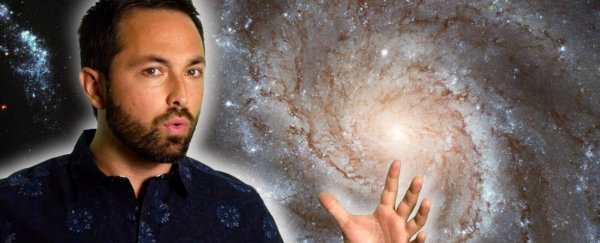We're all familiar with the planets, stars, galaxies, and other massive structures that make up the Universe around us - but many of us are left wondering about the space in between all those structures. It's one of those brain-hurting questions, but what is the nothingness of space made of? And why did galaxies only form in some regions?
At the episode of Veritasium above explains, it's thanks to nothing that the major structures in our Universe formed in the first place. Except that nothingness doesn't really exist… but we'll get to that later.
Let's start with the Big Bang. Contrary to how you might imagine it, the Universe didn't just expand out from a tiny point at a steady rate until we got to where we are today.
That expansion started out steady, but within a fraction of a second, the Universe increased in size by around 1026 times in a very short period of time, known as inflation.
As Derek Muller explains, that period of inflation ended just as abruptly as it began, and then the Universe continued expanding, but at a decreasing rate - it was actually slowing down.
Until about 5 or 6 billion years ago, that is, when researchers suspect dark energy kicked in and sped the expansion up again, which is the state the Universe is in now.
So what does that have to do with the formation of galaxies? Well, to understand that, you need to understand the nature of nothingness.
We think of everything around us as made of particles - atoms, electrons, and so on. But Derek explains that the best theories in physics at the moment are field theories, which state that all particles should be seen just as excitations of fields.
Basically, that means that everywhere across space is covered in a field for each subatomic particle - a neutrino field, a down quark field, and so on. And it's only where there's an excitation - or energy burst - in a region of the field that we observe particles.
In the Veritasium animation below, you can see a subatomic particle field, and energy moving through it as a ripple, or fluctuation. We'd see a particle wherever energy lifts up the field, and the flat parts would appear as empty space.
So the vacuum of space isn't empty at all - it's filled with non-excited subatomic particle fields, just like the one above (before the ripple passes through).
But the thing is, it's actually impossible to make those fields perfectly flat and all zero energy - there are always going to be tiny natural fluctuations.
As the Universe expanded, those fluctuations were blown up to the point where they changed the distribution of matter, and made it possible for giant gas clouds to clump together and eventually form galaxies, stars, planets, and us.
The craziest thing is that you can actually see the imprints of these tiny quantum fluctuations in the leftover radiation from the Big Bang today, which you can check out in the video above (it's so pretty).
And next time you're having a bad day, just remember that without fluctuations in the vacuum of space, none of us would even be here. And that's kind of awesome.

